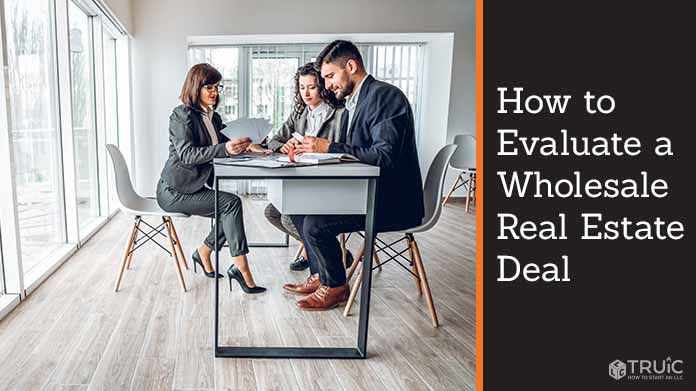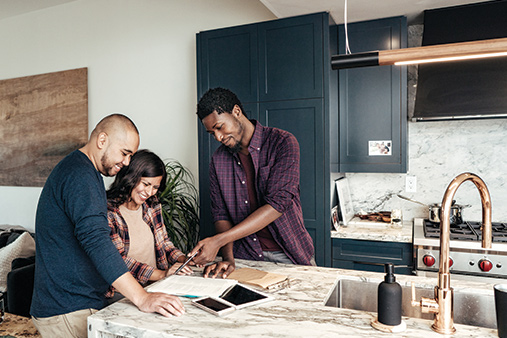How to Evaluate Wholesale Real Estate Properties
You've chosen your market, done your research, followed up on leads, and found a property with wholesale potential. But, there's more work to do before you make an offer or even approach the seller.
You have to objectively evaluate the deal to decide whether or not it meets your criteria for a successful real estate wholesale deal. In this guide, we’ll show you the most important factors you should consider when getting real estate appraisal on a wholesale property.
Recommended: Learn how to start a real estate wholesaling business with our guide.

Methods for Evaluation
While every wholesaler has their own system and methods, there are a few things that everyone should consider. You’ll need to think about:
- Your expected profit — what you hope to make from the deal
- What the eventual buyer will need to spend to get the home market-ready
- Relevant info about the property that can affect its after-repair value (ARV)
- How you’ll calculate your maximum allowable offer (MAO)
- What you’ll need to do to dig deeper and ensure you understand the risks, issues, and opportunities of a wholesale property lead
Determine Expected Profit
This is the amount of money you hope to make after you have assigned the contract to another buyer or investor, and the deal has been closed on.
This is a simple calculation. It's the difference between what the assigned buyer pays and what you agree to pay the seller before the contract has been assigned. If you make an offer of $50,000 and find an investor willing to pay $70,000, your profit on the deal is $20,000.
How much you expect, or want, to make on a deal will vary depending on your market, your experience and business plan, and the property itself. But having a number in mind will help you to set your own expectations. Don't expect more than your market can deliver, and don't settle for too little.
To determine a reasonable profit target, you'll need to learn more about the property.
Learn how to buy wholesale real estate in five easy steps.
Gather Property Info
When you assess a wholesaling deal, it's important to gather as much information about the property as you can. Some of what you'll need is straightforward and easy to get.
This includes data like:
- Year built
- Square footage
- Utilities (e.g., gas or electric, water, etc.)
- Number of bedrooms
- Tax and price history
- Location/neighborhood
In addition to basic data, you should consider any items that may require especially expensive work. Some common areas of concern include:
- Windows
- Air conditioning or HVAC system
- Water heater
- Roof
While the home’s stats and features will help you make appropriate comparisons to other properties, items in need of work will help you calculate how much the eventual buyer will need to spend to bring the property to market-ready condition.
If the house is on-market and currently for sale, much of this information will be included in any online real estate listings, usually along with pictures of the interior. Listings will likely point out any recent repairs or renovations such as upgraded appliances or a new roof or windows.
If you're looking at wholesaling an off-market property, you can still get this information without the need to contact the homeowner or do any fieldwork. Real estate listing websites often include information on houses that are off-market as well, especially if they've been sold in the recent (or even not-so-recent) past.
Once you have this basic property info in hand, you can estimate your profit from a deal. To start, you'll need to calculate the home's after-repair value (ARV).
Looking for Investment Properties for Less?
We recommend using foreclosure.com to find great deals on the most up-to-date, local, and low-cost (distressed, tax liens, etc.) investment properties that would be otherwise difficult to find. With a database that updates twice a day, you can quickly secure your next real estate investment deal and create new opportunities for your business.
Be Prepared for the Worst-Case Scenario
When looking for and researching wholesale properties, it’s important to keep in mind your worst-case scenario. As wholesale homes are often distressed and in need of rehab, it’s unlikely you’ll be connecting an investor with a property that’s ready for market.
This means to expect the unexpected. As a real estate wholesaler, you will deal with properties with unexpected and unforeseen issues and property owners or residents with complicated situations.
You can prepare for the unexpected by knowing your numbers as well as the numbers of your potential investors and buyers. Know your numbers before you visit the property, and then be prepared to adjust based on what you see — remember that your expectations and the eventual offer should always reflect the actual value of the property.
Plan out in advance what you are willing and able to spend on a property and how much you’ll need to make as the wholesaler to make the deal worthwhile.
Consider Your Buyers and the Real Estate Investor Mindset
As a new wholesaler, you may not always know what particular investors are willing to spend, or their target profit margins.
But as you make deals and get to know your buyers, you’ll gain an understanding of how they work. This will help you to know in advance which properties will be suitable for which investors, depending on location, price point, and the work needed for rehab, renovation, and repairs.
When evaluating a wholesale property, it’s important to keep in mind your goal — to assign the contract to the right investor. That means focusing on suitable properties that fit the criteria of buyers and investors.
How to Calculate After-Repair Value
A home's ARV is the expected price of the home once it has been renovated. Unlike a house flipper, a real estate wholesaler won't be responsible for repairs. Your role is to connect a motivated seller with a suitable investor.
But you still need to consider the costs of getting a house market-ready. The ARV, along with the cost of repairs, will affect both how much you offer the homeowner and how much you can expect an investor to offer you for the wholesale property.
Calculating a Home's ARV
There's no one, foolproof method to calculate ARV. It will always be an estimate, and the final price of the home may be higher or lower.
However, you can make your estimated ARV more accurate by researching your housing market. In addition to researching the potential wholesale property, you should:
- Review sale price history for similar houses in the area. A common benchmark for comparison is homes within one mile that have sold within the last 6 to 12 months. A longer view, as much as three to five years, is ideal but not always necessary.
Viewing prices over time will give you an idea of both what houses tend to sell for and whether prices are trending up or down. If prices are trending downward, you may need to lower your estimate. But if trends are positive, you may be able to ask for a higher price when you wholesale the house. - Focus on houses that were flipped. Houses that were bought either by a wholesaler or a flipper will give you the most direct comparison. Look especially at houses that sold low and then sold for a higher price soon after – these houses were likely purchased by an investor or real estate wholesaler.
- Consider the price per square foot. Housing prices can vary depending on many factors, including size. Using the cost per square foot lets you make a more direct comparison between houses, and looking at multiple recent real estate sales helps you zero in on an average cost per foot for your area. Then simply multiply the cost by your house's square footage to get to a solid starting point in calculating ARV.
With research and a little number crunching, you will be able to arrive at an ARV for the property, and you'll be ready for the next step in evaluating the wholesaling deal.
Estimate Repair and Renovation Costs for the Wholesale Property
Before you can arrive at a price range that works for your finances and business plan, you have to estimate how much it will cost to repair or renovate the house after it is sold.
However, as the wholesaler you will not be making or contracting any repairs yourself, your eventual buyer will. And you can be certain that they will factor repair costs into what they are willing to pay for a wholesale property.
How precise an estimate you make can depend on a number of factors, such as your access to and knowledge of the property and your previous real estate experience.
Depending on your relationship with the seller, you may be able to have contractors provide estimates in advance. Even without direct access to the property, you can research costs in your area. Seasoned investors who have closed wholesaling and other deals in the past will develop a good sense of what the cost of repairs might be.
Just remember that the repair number you land on may change. When it's time to assign the contract, the buyer will likely have done their own research and come with their own repair estimates.
Once you have the property's ARV and have estimated repair and renovation costs, you can calculate your maximum allowable offer (MAO) for the wholesaling deal.
Follow the 70% Rule to Calculate Your MAO
This is a common rule of thumb followed by many investors. Use the 70% rule to determine your maximum allowable offer.
Real estate investors and wholesalers use the 70% rule to decide how much they should be willing to spend on a house. The rule dictates that you should not pay more than 70% of the estimated sale of the house, minus purchase price, cost of repairs, and your expected profit.
Consider this hypothetical:
- Estimated ARV: $250,000
- Cost of repairs: $25,000
- Your profit : $10,000
$250,000 x 0.7 = $175,000
$175,000 - $25,000 - $10,000 = $140,000.
This means your MAO is $140,000. You should not offer any more than that for the property in order to earn your desired profit of $10,000.
The 70% rule is the most common method of calculating your MAO. Some investors will be willing to accept thinner margins and will spend more (75%+), while others who prefer less risk may use a lower number.
Whichever approach you take to calculate your MAO, just remember that the wholesaling process doesn't end when your offer is accepted. You'll still need to find an investor willing to meet whatever price you set.
Visit the Property
Once you’ve researched the property, calculated the house’s ARV, and determined your MAO, you should have a good idea of whether or not this a wholesaling deal that’s worth pursuing.
But no matter how many calculations you perform and how much information you amass, nothing can substitute for actually seeing the property yourself. Your ARV and MAO are theoretical estimates, and online listings aren’t always up-to-date.
Before you make contact with the homeowner of the property, or begin seriously pursuing the deal, you should see the property for yourself.
What this involves, and how closely you can examine the house, depend on a few factors:
- Is the property in your home market? Can you easily drive there to see it yourself?
- Is the homeowner of the distressed property living in the home, or is it vacant?
- Is the property currently on-market? If yes, is it for sale by owner, or are they represented by a real estate agent?
- How easy will it be to make contact with the homeowner to discuss a sale?
Evaluating Wholesale Properties in Your Area
If the wholesaling lead is in your area, you should visit the property and at least view it from the outside. This is a simple way to rule out potential wholesale properties with obvious and expensive problems. Issues with the property could range from cosmetic defects that would be difficult to fix, to serious structural damage.
If you’re looking for distressed properties to invest in, a subscription to foreclosure.com may be what you need. Oftentimes, distressed properties are difficult to find, but this website will provide you with many local options and is updated twice a day, which could be useful in getting ahead of the competition to secure your next investment deal.
Besides just ruling out distressed properties that would be difficult to assign to an investor, viewing the property will help you to calculate your MAO. You can begin assessing the condition of the house and figuring out what repairs will be needed to get the property market-ready.
Evaluating On-Market Wholesale Properties
If the house is on-market and actively for sale, the process is much more straightforward. You’ll simply need to get in touch with either the seller or their agent if they are being represented by a real estate agent.
This is a less common scenario, however. Most wholesale property leads you pursue will likely be off-market. Depending on your marketing strategy, sellers may reach out to you, or you may be the one to make contact.
Evaluating an Off-Market Property
When a property is not being actively marketed, you will be the one to make contact and reach out to the homeowner. This is an essential part of the process and provides a way of getting more access to the property.
Directly contacting a homeowner should be one of the last steps you take in evaluating a potential wholesale property. In most cases, you will wait to do this until you have evaluated the deal, calculated the ARV, found your MAO, and know what you expect to make from the assigned contract.
Assessing the Wholesale Lead and Making a Decision
If you’re still thinking about starting your real estate wholesaling business, you’ll want to start an LLC to formalize your business and gain credibility. Once you’re up and running your company, and have secured a network of investors, you may want to consider an S Corp tax status for your wholesaling business.
As an IRS tax classification, an S corp can provide your real estate business with certain tax benefits. You can find out more if an S corporation is right for you with our LLC vs S Corp guide.
In real estate investing, and wholesaling in particular, due diligence is the key to success. Before making a decision, you need to research and plan:
- Research the property
- Estimate the home’s ARV and potential renovation costs
- Use the 70% rule to calculate your MAO
- See the house in person
Although formulas are part of the process, a formula can’t always tell you whether to or not to pursue a wholesaling lead and make an offer. And regardless of what the numbers say, there are no guarantees in real estate investing. A sure thing may fall through, or a long-shot lead may pay off in the end.
The key to success at wholesaling is planning, diligence, and the ability to make the right call at the right time. By following the steps and principles outlined here, you will be well-positioned to capitalize on whatever investment opportunities come your way.


